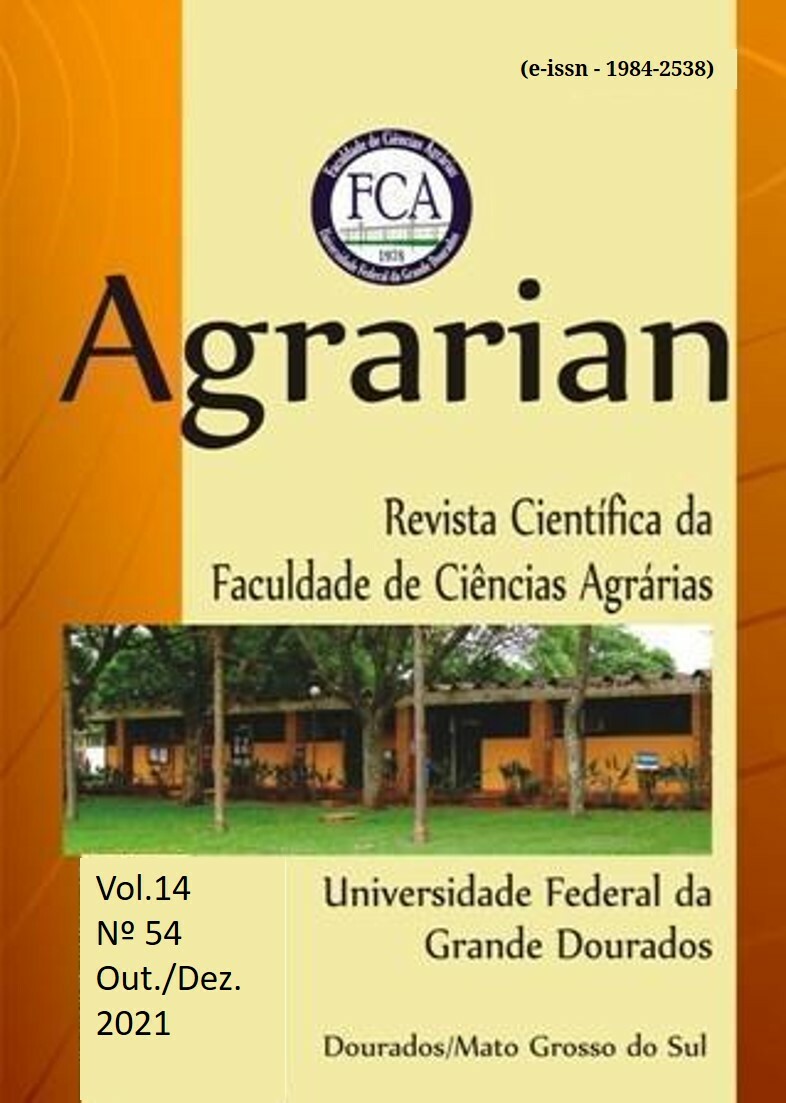Effect of hailstorm on Arabica coffee varieties by means of vegetation indices
DOI:
https://doi.org/10.30612/agrarian.v14i54.13940Keywords:
Remote Sensing., Precision Agriculture., NDVI.Abstract
Data obtained by Remote Sensing can help in the monitoring, identification and mapping of crop-related characteristics, mainly through vegetation indexes (IV). In this sense, this study aimed to evaluate variety indexes in the Arabica coffee varieties Mundo Novo and Catuaí, before and after the hailstorm. The stories occurred in January 2019 on the dates before and after the occurrence of the phenomenon using the NDVI and NDRE vegetation indices. The data from the IVs were analyzed using descriptive statistical analysis and spatial analysis using thematic maps on the evaluated dates. He found that the vegetation indexes were higher after hail transformation, demonstrating that they were not able to detect defoliation, probably due to phytosanitary treatment applied in sequence to hail rain. The NDRE index is more sensitive than the NDVI to capture variations in IVs in Arabica coffee varieties.
Downloads
References
Amaral, L.R., Molin, J.P., Portz, G., Finazzi, F.B., & Cortinove, L. (2015). Comparison of crop canopy reflectance sensors used to identify sugarcane biomass and nitrogen status. Precision Agriculture, 16(1), 15-28. https://doi.org/10.1007/s11119-014-9377-2
Carter, G.A., & Knapp, A.K. (2001). Leaf optical properties in higher plants: linking spectral characteristics to stress and chlorophyll concentration. American Journal Of Botany, 88(4), 677-684. https://doi.org/10.2307/2657068
Crusiol, L.G.T., Carvalho, J.D.F.C., Sibaldelli, R.N.R., Neiverth, W., Rio, A., Ferreira, L.C., Procópio, S.O., Mertz-Henning, L.M., Nepomuceno, A.L., Neumaier, N., & Farias, J.R.B. (2017). NDVI variation according to the time of measurement, sampling size, positioning of sensor and water regime in different soybean cultivars. Precision Agriculture, 8(4), 470-490. https://doi.org/10.1007/s11119-016-9465-6
Fitzgerald, G.J., Lesch, S.M., Barnes, E.M., & Luckett, W.E. (2006). Directed sampling using remote sensing with a response surface sampling design for site-specific agriculture. Computers and Electronics in Agriculture, 53(2), 98-112. https://doi.org/10.1016/j.compag.2006.04.003
Kanke, Y., Tubaña, B., Dalen, M., & Harrell, D. (2016). Evaluation of red and red-edge reflectance-based vegetation indices for rice biomass and grain yield prediction models in paddy fields. Precision Agriculture, 17(5), 507-530. https://doi.org/10.1007/s11119-016-9433-1
Lowe, A., Harrison, N., & French, A.P. (2017). Hyperspectral image analysis techniques for the detection and classification of the early onset of plant disease and stress. Plant Methods, 13(1), 80. https://doi.org/10.1186/s13007-017-0233-z
Molin, J.P., Amaral, L.R., & Colaço, A.F. (2015). Agricultura de precisão. São Paulo: Oficina de Textos.
Pinto Neto, J.N., Alvarenga, M.I.N., Corrêa, M.D.P., & Oliveira, C.C.D. (2014). Efeito das variáveis ambientais na produção de café em um sistema agroflorestal. Coffee Science, 9(2),187-195. https://doi.org/10.25186/cs.v9i2.597
Pimentel-Gomes, F. (1985). Curso de Estatística Experimental. 12. ed. Piracicaba: Livraria Nobel. 467p.
Putra, B.T.W., & Soni, P. (2017). Evaluating NIR-Red and NIR-Red edge external filters with digital cameras for assessing vegetation indices under different illumination. Infrared Physics & Technology, 81(2), 148-156. https://doi.org/10.1016/j.infrared.2017.01.007
Vian, A.L., Bredemeier, C., Silva, P.R.F., Santi, A.L., & Giordano, C.P.D.S. (2018). Limites críticos de NDVI para estimativa do potencial produtivo do milho. Revista Brasileira de Milho e Sorgo, 17(1), 91-100. https://doi.org/10.18512/1980-6477/RBMS.V17N1P91-100
Downloads
Published
How to Cite
Issue
Section
License
Copyright (c) 2022 Sonia Armbrust Rodrigues, Jorge Wilson Cortez, Hermano Jose Ribeiro Henriques

This work is licensed under a Creative Commons Attribution-NonCommercial-ShareAlike 3.0 Unported License.
Authors who publish with this journal agree to the following terms:
Authors authorize the publication of the article in the journal.
The authors ensure that the contribution is original and unpublished and is not being evaluated in other journal.
- The journal is not responsible for the opinions, ideas and concepts expressed in the texts because they are the sole responsibility of the authors.
- The publishers reserve the right to make adjustments and textual adaptation to the norms.
- Authors retain copyright and grant the journal right of first publication with the work simultaneously licensed under a Creative Commons Attribution License that allows others to share the work with an acknowledgement of the work's authorship and initial publication in this journal.
- Authors are able to enter into separate, additional contractual arrangements for the non-exclusive distribution of the journal's published version of the work (e.g., post it to an institutional repository or publish it in a book), with an acknowledgement of its initial publication in this journal.
- Authors are permitted and encouraged to post their work online (e.g., in institutional repositories or on their website) only after publication.



